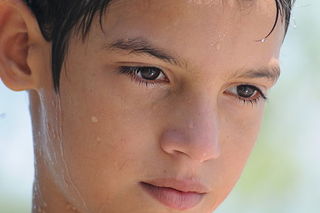Beauty
Indoctrinating Children
Cartoon movies start anti-male propaganda with the very young.
Posted August 14, 2016

If you don’t have a son, imagine you do.
The trouble with boys
In 1970, we decried what was happening to girls because boys were 69% of those in college. Today, boys are only 42% but there is no comparable affirmative action, teacher training, or male-focused scholarships to counter the imbalance. Of course, that has profound impact because today, post-secondary education is virtually a prerequisite for good employment.
These are but two examples of todays' boys' plight. The Coalition to Create a White House Council on Boys and Men conducted this review of the literature, citing many more examples.
Yet look at societal efforts---governmental, education, nonprofit, and media--and one would think that girls are floundering more than boys are, and that society is willing to destroy boys' sense of worth to help the girls.
Children's movies
For example, all movies have positive and negative characters, and women’s activist groups, recognizing the power of role models, have successfully pressured filmmakers to portray females disproportionately positively compared with white males. Those activist groups have been successful all the way down to movies aimed at young children.
A movie gets to be a blockbuster heavily because the film companies spend much more on making and marketing certain films and because the media chooses to give only certain movies millions of dollars in free positive publicity.
A look at the all-time biggest box-office children's cartoon movies makes clear the gender (and race and class) message that the activist groups, filmmakers, film companies, and the media want to send .
Shrek2: #1 all-time biggest box office. The green Shrek heroically foils the evil, rich white King Harold. Shrek 1 was the same: The heroic green Shrek beats the evil, white, rich Lord.
Note that in both of these movies as well as in, for example, Frozen The Little Mermaid, and Beauty and the Beast below, the filmmaker made the villain a member of royalty--an atavistic tiny group that obtained their money without effort. That not only maximizes the viewers' antipathy toward them but implies to naive children that most wealth is obtained unfairly—class warfare starts young.
Finding Nemo, #2 all-time box office. The dark blue fish (Ellen De Generes) saves a lighter-skinned male clownfish.
Finding Dory. #3 all-time box-office. The dark blue fish (Ellen De Generes) finds her family despite the bad moves by the inferior (and lighter-skinned males) Hank and Marlin.
Toy Story 3: #4 all-time box office. The heroes are three males and three females. The villain Is Lotso, the cruel white male (Ned Beatty) boss at a child-care center.
Monsters Inc. #5 all-time box office. Mary and Roz foil the evil Henry J. Waternoose and James P. Sullivan.
Frozen. #6 all-time box office. Elsa (Idina Menzel) conquers the evil, white, rich Duke and Hans.
Other wildly popular children’s cartoon movies of the last two decades:
Beauty and the Beast. Belle spurns the idiotic white male hunter Gaston and spunkily fights against the white men’s belief that the dark-skinned Beast is evil and must be destroyed. She recognizes that a kindly person lies within the Beast and tames him.
Pocahontas. She is the tattooed, Native American equivalent of Belle.
The Little Mermaid. The mermaid sacrifices her life rather than kill the inferior, elitist, white, rich prince.
Inside Out. Kaitlyn Dias conquers the voices within, the worst of which was Anger, played by a white male.
Mulan. The Asian woman, Mulan, triumphs over a misogynistic patriarchal regime to become a warrior who destroys the Huns, all men.
A walk-through of Beauty and the Beast
I just saw the play, Beauty and the Beast. Here's a walk-through. Do you think the sexes and races are portrayed fairly?
1.The white prince refuses, in the most cruel way, to help a waif. (Again note that, so often, the evil character is royalty—Rich without having earned it.)
2. The villagers are milling: The girls are playing, moms holding their hands, the boys are being paddled by their dads, while the heroine, Belle (the heroine,) is reading a book.
3. We meet the white male Gaston, the story''s antagonist, an impossibly terrible boor, priding himself on his body and his duck hunting. He crows, "I'm the best. Don't I deserve the best in a wife. And beauty in a girl is all that counts. He then swaggers to Belle. In the play, he says, "Why don't you get your pretty little head out of that book and pay attention to something important? Me." Here's that scene in the movie.
When she demurs, he pushes himself at her and barks, "You are going to marry me. We will have 6 or seven kids—all strapping boys of course, like me, while you massage my feet. So, is your answer "Yes" or "Oh yes!" Of course, Belle one ups him cleverly by responding, "I don't deserve you."
4. When her father is absconded with into the woods, and she had never been in the woods before, she asks Gaston's white male sidekick to guide her. He says he's scared. She says, "Never mind. I can do it myself." And of course, she does.
5. The castle servants (all better people than the prince--There's that class warfare meme again) make fun of the prince's chief of staff (an angry white male) but when they hear there's a a female is in the castle (Belle), they're atwitter.
6. She demonstrates superhuman generosity by offering to take her aging father's place in the dungeon for the rest of her life if the prince/beast will release him. Evilly, he agrees.
7. The female servants give her good advice on how to deal with the prince/beast. Throughout the play, they do so. They are perfect.
8. The prince/beast orders her to come to dinner. To avoid him, she says she's not hungry. He barks "I'll tell you when you're hungry!"
A general note: As in most movies as well as plays, in every argument with him, her cleverness trumps his brutishness.
9. To open Act II, she beats off an entire pack of wolves by herself and when the Beast tries to help, the wolves bite him badly and despite his craven cruelty to her and her father, she turns the other cheek and is so skilled that she's able to bring him back to health.
10. The Prince/Beast is illiterate and she has to read to him.
11. Gaston tries to get her back by getting her father committed as insane. He enlists the help of DeLoon, a white male.
12. When that fails, Gaston grabs her and forces a kiss. She spunkily rebuffs him.
13. The 10 invaders of the castle, all men, mostly white, are beaten by the "dishes" and "silverware" (mostly women) and a gay guy. The prince is AWOL. Workers good, leaders bad.
14. When Gaston tries to kill the Prince/Beast, she kills Gaston.
15. Because of her brilliance and bravery, she tames the prince into being a loving person.
The overall message, as always: Women have spunk, savvy, and agency. White men are far inferior.
It's not just children's movies
In any category of film or TV sitcom or drama, or even commercials, can you find an unedited list of blockbusters in decades in which all the heroes are males, let alone white males, let alone wealthy, contributory white males, and the villains are all women and minorities?
Especially in light of the aforementioned terrible statistics for boys versus girls, is the biased gender role-modeling fair to your son? Is it good for society?
Dr. Nemko's nine books are available. You can reach career and personal coach Marty Nemko at mnemko@comcast.net.




